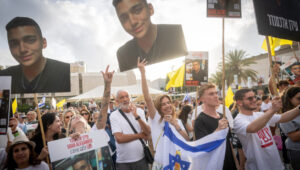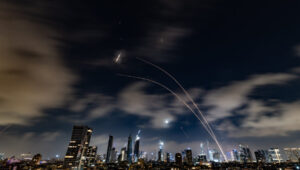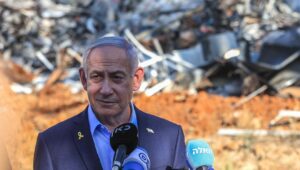Alireza Nader, the engagement director at the National Union for Democracy in Iran (NUFDI) spoke in a recent webinar at the Middle East Forum and explained how widespread the recent Iran protests were. He claimed that since the murder of Mahsa Amini, protests have erupted in every region in Iran, from the smallest village to the largest city. He noted that the protests broke out because of the slaughter of political dissidents and the manner in which the regime abuses the Iranian population.
Sirwan Mansouri, a Kurdish journalist based in the Middle East, said, “After the killing of a Kurdish girl named Mahsa Amini under the pretext of chastity by the Islamic Religious Police six months ago, demonstrations began. The difference between these demonstrations and previous demonstrations is multi-dimensional. Firstly, it was not because of economic problems but rather the lack of freedom. Secondly, it covered the whole country and not just certain problems. Thirdly, women were at the forefront. Fourthly, the ethnic minorities were the main core of the demonstrations. The wall of fear in Iran has fallen and people are no longer afraid of the regime. They insist on their basic rights and challenge the regime.”
Nader claimed that the protesters are young people who are no longer afraid to disobey the religious laws established by the government, such as mandatory hijab. During the demonstrations, Iranians began to develop their national history unrelated to Islam by highlighting figures from the country’s pre-Islamic past, such as Cyrus the Great. King Cyrus became the symbol of the country’s opposition to the ayatollah’s rule, with his birthday being celebrated for several years. In addition, non-Islamic Persian holidays like Novruz are celebrated with renewed intensity. During the current wave of protests, there were members of the Iranian Revolutionary Guards who changed their mind and joined the resistance. But there are also a great many people who continue to support the ayatollahs, which helps their government to maintain power.
“The protests in Iran are still ongoing but not like it was a few months ago or even in February,” stressed Tarlan Ahmadov, who is the president of the Azerbaijan Society of Maine. “People are still protesting, sometimes peacefully, especially women are there openly talking about their rights. But as we know, the cruelty of the Iranian regime is constant. They are becoming crueler than they were a few months ago. They are imposing a push to bring back the hijab. Minorities like Azerbaijanis are under huge persecution and face a non-stop violation of their human rights.”
He claims that the protests are dying down due to the lack of global support: “They are almost not reacting to this ongoing violation by the regime’s cruelty. Just saying something is not enough. They have to have an active push to support the protesters, maybe with weapons, to change the situation. It has become so frustrating. The willingness to stop the Iranian regime is not in place at the moment. Iran has also behaved aggressively towards other countries, such as Azerbaijan and Israel. This is not acceptable. The governments of the world have to stop this aggression. Iran’s nuclear weapons are a world threat. They are a destructive force in the whole Middle East. This must be somehow addressed.”
Sources inside of Iran describe the Islamic Republic of Iran’s unimaginable cruelty towards women, who are one of the most dominant groups in the protests. The Islamic Republic of Iran literally poisoned young school girls using chemical gas in middle schools and high schools, prompting many of them to end up in the emergency room and hospitalized because they have been chemically poisoned. Additionally, Iran has installed cameras all over the country in order to crack down harder on mandatory Hijab law in Iran over the decades in the country.
There is a broad consensus that the revolution is driven mainly by young people and movements. There are many leaders, a leader for each organization and a leader for each region in Iran. There are also leaders who are not willing to reveal themselves due to the fact they fear for their lives. Some have been killed and others have been imprisoned. Reza Pahlavi, who visited Israel this year on Holocaust Memorial Day, is the heir to the Pahlavi dynasty and could be the next ruler of Iran.
Nader claims that Pahlavi is “the most popular leader. He follows what is happening in Iran and many demonstrations in 2017 were held under his leadership. He can unite all protesting organizations together but also has the leadership qualities that Iranians living in Iran and abroad appreciate. He and his people want to establish a constitutional monarchy in Iran, but more in the direction of a parliamentary republic. This man made the Iranian opposition much more united.”
Mansouri profoundly disagrees: “Reza Pahlavi and his supporters are trying to confiscate the revolution. They think that they are the owners of this movement and look at it as their property, while this movement started inside the country. People inside Iran were united on the streets against the regime, chanting ‘women, life freedom.’ This was the central slogan and manifesto of this revolution. But some opposition groups started to advocate for the Pahlavis, changed the path of the movement and made society multipolar. People who were protesting against the regime in the first months now went home because they realize that their lives are lost for the benefit of some opposition groups.”
Ahmad Obali, chairman of international relations committee at the South Azerbaijan National Freedom Front and founder of Gunaz TV, believes regardless of the protests subsiding, the protests will come back stronger and is not as negative as Mansouri: “Even if it does not come back in the short time, it will come back anyways for the people are extremely sick of the government at the moment. They have no hope for the future. They think that the only hope is to continue protesting and overthrow the government.” In order to counter this,Obali predicts that the regime will create more crises in the region, especially to the north around Azerbaijan: “Iran can use this as a way out of the crisis internally, claiming that Iran is in a big dispute with neighboring countries, so the dispute should be there. So in the short and mid-term, Iran will create a bitter crisis with Azerbaijan.”
According to him, “Therefore, the demonstrations will continue, even though they died down at the moment. But they will come back and continue.” Obali does think it is a mistake to look only at the Pahlavis when thinking of these protests: “The world must focus on the ethnic aspect of the movements in Iran, especially Kurds, Baloch and Azerbaijanis. Strategically, the protests will continue and the government will go eventually, and the ethnic minority groups will have their say in the future of Iran. Therefore, the focus on ethnic minorities will not only bring the end of the current government sooner, but will also stabilize the Middle East, bringing peace and democracy to the region.”
Iranian political theorist Dr. Reza Parchizadeh, author at the Center for Security Policy concluded: “The main goal of the revolution is to establish democracy with a focus on women’s freedom and the empowerment of the underprivileged groups, such as the ethnic groups and other minorities. The leadership of the revolution is horizontal and net-work based, and there has been anunparallel cooperation and coordination between different sectors of the society to challenge the Islamic Republic and amplify the voices of the freedom seeking people of Iran to reach the outside world.”
According to him, “The most progressive human, political, social and cultural concepts such as the freedom of women and sexual minorities, multi-ethnicity and multiculturalism in Iran, the need to substantially change the historical structure of power and decentralize the government, and equality between all Iranian people regardless of their origin and background have been at the heart of the revolution. Despite the fact that the initial fervor of the revolution has subsided to some extent due to the repression of the regime, the protesters show their opposition in different ways and still seek to topple the Islamic regime and establish democracy.”
















The Americans mustn’t know that the Obama, sorry Biden administration’s support of Iran is suppressing women in this way. They would surely support the women if they knew.
We have to pray for, and have right regard for all appointed governments. (Titus 3:1; 1 Tim 2:2) However, rulers must be mindful that they too have a ruler in heaven to whom they are accountable. (Eph 6:9) God entrusts such rulers with great responsibility for His people, so they need to treat their people as God’s children. Persia is booked to join a confederacy against Israel. (Ezk 38:5) You’d think it more likely to be an Ayatollahs than a Parliament’s Iran.
Shalom Yisrael Hayom…
The scripture is clear, Iran will be reduced to only a bit player in Yehez’qel 38, considering their judgment in degree is set in Yir’m’yahu 49:34-39… with their final end in Yehez’qel 38… There is a soon coming day when muslims will wake up and decide it is not mag’niyv to be a muslim…. Elohim’ name WILL BE SANCTIFIED in the eyes of the nations… Game set match… The Cosmic chess match concluded in Beresheit 3:15…